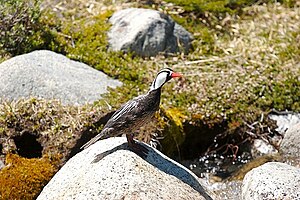Water duck
| Water duck | ||||||||||||
|---|---|---|---|---|---|---|---|---|---|---|---|---|

Common blue duck ( Merganetta armata ) |
||||||||||||
| Systematics | ||||||||||||
|
||||||||||||
| Scientific name of the genus | ||||||||||||
| Merganetta | ||||||||||||
| Gould , 1842 | ||||||||||||
| Scientific name of the species | ||||||||||||
| Merganetta armata | ||||||||||||
| Gould , 1842 |
The red duck ( Merganetta armata ) is a South American species of bird from the family of ducks (Anatidae) and belongs to the subfamily of demi-geese ( Tadorninae ). It is the only species in the genus Merganetta . The division of the red tinker duck into three subspecies is controversial: the Chile tusk duck ( Merganetta armata armata ), the Peruvian tusk duck ( M. a. Leucogenis ) and the Colombian tomb duck ( M. a. Colombiana ) are also each considered by some scientists as independent Sorted. The closest recent relatives are the Salvadoran ducks and the New Zealand duck-billed duck .
The torrent duck is a highly specialized duck that inhabits rapid mountain rivers in various vegetation zones and is one of the few species of duck that is rarely kept in captivity. Little is known about the size of the common water duck. However, it is classified as relatively common in Chile and Argentina.
Appearance
Water ducks reach a body length of 43 to 46 cm and a weight of 315 to 440 grams. They are only a little bigger than the teal duck . The body is streamlined and slim. The long tail feathers with their strong quills and their narrow, bristle flags stand out as a striking feature.
The plumage of adult torrent ducks is very different depending on the subspecies, but what all subspecies have in common is that the males have white head plumage, a black center parting and a curved black line along the side of the head and neck. The plumage on the body is always dark, in some subspecies partly brown, in other subspecies completely or partly black. In the males of all three subspecies, the back plumage is lined with white of different widths. The male also always has a red beak. In both sexes, the beak is saw-like narrow and soft.
The females are slightly smaller and have a dark head and dark tail feathers, the breast and front belly are strong red-brown. The plumage of young birds is usually composed of a gray back and a white belly plumage.
Way of life
The breeding season depends on the respective distribution area. The nest is made in caves, between stones and in tall grass, it consists mainly of dry grass and is padded with down. As a rule, a clutch consists of 3 to 4 eggs and the incubation period is 43 to 44 days. The chicks show a striped and dotted, black and white down plumage.
The majority of the diet consists of aquatic invertebrates - including above all the larvae of quiver flies , stone flies and mayflies and, to a lesser extent, mollusks . The food is sought above all by diving and digging. Insect larvae are picked out of stone cracks with their soft beak. With this way of life, the red spotted duck is very similar to the frilled-billed duck . Similar to this, it suffers from the food competition from imported rainbow trout , which also eat the larvae of various species of flies.
Occurrence
The turmeric duck lives in South America along the entire Andes from Venezuela to southern Chile and Argentina . It is an inhabitant of fast-flowing mountain streams and along these waters defends its territories, which include both fast-flowing and slow-flowing areas. Apart from the south of Chile, it usually stays at altitudes between 1200 and 4500 meters. In the south of Chile, however, it can also be found at lower altitudes. The habitats inhabited by the torrent include regions of rainforests and cloud forests, the mountain rivers in the Puna zone in Peru and the subtropical and temperate beech forests of Chile and the subarctic regions of South America.
Keeping in captivity
Water ducks are very rarely kept in captivity. Institutions with experience in duck keeping, such as the British Wildfowl Trust , have so far not been able to keep this species for a longer period of time. The greatest challenge in keeping is the high susceptibility of this species of duck to endoparasites, infectious and fungal diseases. The ducks are also so aggressive towards one another that keeping them individually is necessary.
Subspecies
Six subspecies are described, which differ in their color, size and range. These are:
- Merganetta armata armata Gould , 1842
- Merganetta armata turneri Sclater, PL & Salvin , 1869
- Merganetta armata garleppi Berlepsch , 1894
- Merganetta armata berlepschi Hartert , 1909
- Merganetta armata colombiana Des Murs , 1845
- Merganetta armata leucogenis ( Tschudi , 1843)
supporting documents
Individual evidence
swell
- Josep del Hoyo , Andrew Elliot, Jordi Sargatal : Handbook of the birds of the world. Volume 1: Ostrich to Ducks. Lynx Edicions, Barcelona 1992, ISBN 84-87334-10-5 .
- Janet Kear (Ed.): Ducks, Geese and Swans. Oxford University Press, 2005, ISBN 0198546459 .
- Hartmut Kolbe; Die Entenvögel der Welt , Ulmer Verlag 1999, ISBN 3-8001-7442-1
Web links
- Videos, photos and sound recordings of Merganetta armata in the Internet Bird Collection
- Merganetta armata inthe IUCN 2013 Red List of Threatened Species . Listed by: BirdLife International, 2012. Retrieved September 20, 2013.
